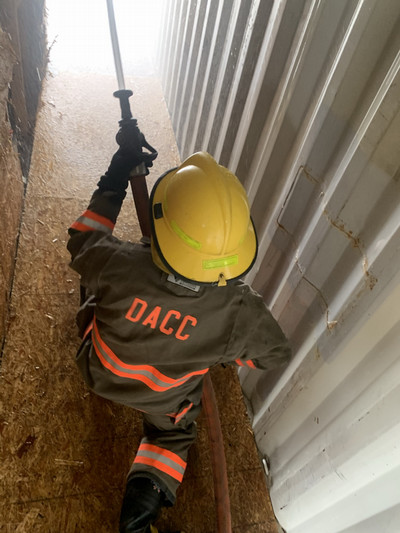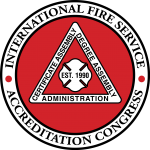About

NOTE: This program does not emphasize firefighter operations. Instead, it focuses on theory, investigation, prevention, and management, Students wishing to enter the fire service may benefit from the general background provided and may receive certifications in various fire-related areas through the New Mexico Firefighters Training Academy in Socorro, N.M.., and the International Fire Service Accreditation Congress (IFSAC).
Every year, fire and other emergencies take thousands of lives and destroy property worth billions of dollars. Firefighters help protect the public against these dangers. They are frequently the first emergency personnel at the scene of a traffic accident or medical emergency and may be called upon to put out a fire, treat injuries, or perform other vital functions.
Firefighters work in a wide variety of settings, including urban and suburban areas, airports, chemical plants and other industrial sites, and such rural areas as wildlands and forests. When wildland fires break out, crews of firefighters are brought in to suppress the fires with heavy equipment and hand tools. in addition, smoke jumpers parachute into inaccessible areas. Others who have been trained for the control, prevention, and cleanup of hazardous materials incidents work in hazardous materials units.
Employment of firefighters is expected to grow about as fast as the average for all occupations, as fire departments continue to compete with other public safety providers for funding. According to the United States Fire Administration, nearly 70 percent of fire companies are staffed by volunteer firefighters. Most job growth will occur as volunteer fire-fighting positions are converted to paid positions. In addition to job growth, openings are expected to result from the need to replace firefighters who retire, stop working for other reasons, or transfer to other occupations.
Program Goals
Program Student Learning Outcomes
The Doña Ana Community College Fire Science Technology Program awards an Associate of Applied Science Degree through a FESHE compliant curriculum designed to provide education and skills essential for those who are seasoned professionals seeking career advancement and for those who are new to Fire Science professions and would like to pursue a career in these fields.
Upon completion of the Fire Science Associate of Applied Science degree, students should be able to:
1. Develop an awareness of the entrance requirements for careers in the fire service.Objectives:
- Identify entrance requirements for fire service organizations.
- Develop the skills necessary to perform in a mock fire department entrance interview.
2. Describe the structure and operational management of fire service organizations.
Objectives:
- Describe the fire department’s organizational structure.
- Within the organizational chain of command, apply appropriate supervisory techniques.
3. Develop the skills necessary to investigate and prevent fires and understand the role of building construction and fire behavior principles as they apply to firefighting.
Objectives:
- Using a variety of assessment tools, demonstrate the ability to investigate and determine the cause of the fire.
- Using a variety of assessment techniques, determine building safety by applying appropriate codes and regulations.
- Identify the different types of building construction and use them to evaluate their impact on firefighting operations.
4. Acquire the skills and knowledge required to perform the functions of a firefighter.
Objective:
- Attain certifications to demonstrate firefighting competence with a target success rate of 80%.
5. Apply the appropriate critical thinking skills necessary to develop an incident action plan using appropriate strategies and tactics to safely manage incidents.
Objective:
- In a simulated incident, demonstrate competency in developing and implementing an incident action plan using the Incident Command System and appropriate safety principles.
Explore
Firefighters work in a wide variety of settings, including urban and suburban areas, airports, chemical plants and other industrial sites, and such rural areas as wildlands and forests. When wildland fires break out, crews of firefighters are brought in to suppress the fires with heavy equipment and hand tools. in addition, smoke jumpers parachute into inaccessible areas. Others who have been trained for the control, prevention, and cleanup of hazardous materials incidents work in hazardous materials units.
Employment of firefighters is expected to grow about as fast as the average for all occupations, as fire departments continue to compete with other public safety providers for funding. According to the United States Fire Administration, nearly 70 percent of fire companies are staffed by volunteer firefighters. Most job growth will occur as volunteer fire-fighting positions are converted to paid positions. In addition to job growth, openings are expected to result from the need to replace firefighters who retire, stop working for other reasons, or transfer to other occupations.
Job Opportunities
Mission, Vision and Values
Mission Statement
The mission of the Fire Science Program is to provide a diverse community of students the opportunity to develop technical, academic and professional competencies required for fire service careers.
Vision Statement
Doña Ana Community College Fire Science Program intends to be recognized as an outstanding accredited entity promoting professionalism among its fire and emergency services community.
Values
- *Enhance fire service professional qualifications
- *Enhance and promote career opportunities through comprehensive training and education
- *Enhance student learning by ensuring the student receives up-to-date training/education instruction that reflects current industry practices
- *Enhance the program’s relevancy within the fire industry by keeping up with emerging trends
Program Accreditation

The two-year Fire Science Technology degree at Doña Ana Community College is accredited by the International Fire Service Accreditation Congress (IFSAC)
Additional Information
Doña Ana Community College provides training for firefighting personnel through its Fire Science Technology program, which is accredited by the International Fire Service Accreditation Congress. This program provides classroom instruction leading to an associate of applied science degree in fire science technology or a certificate of completion in firefighting. It is suited to those who are new to the field, as well as seasoned firefighters:
- Career and volunteer firefighters and NMSU student firefighters will improve their job performance and prepare for higher level positions in the fire protection fields.
- Students who wish to enter the field of fire protection will benefit from the basic foundations provided in the technical courses as well as general education courses.
NOTE: An articulation agreement exists with the New Mexico Firefighters Training Academy that makes it possible to receive college credit for experience and IFSAC certification. All courses in this program may be applied toward a Bachelor of Applied Studies or Bachelor of Individualized Studies degree at NMSU.
Students must receive a C or better in each course in order for it to apply toward graduation.
Medical/Accidental Injury Insurance Notice:
DACC does not provide medical insurance for students. DACC students are encouraged to obtain their own medical insurance for any illness, accident or injury that might occur during the span of this course. Visit www.healthcare.gov to shop for, compare costs and coverage benefits, and enroll in insurance coverage.